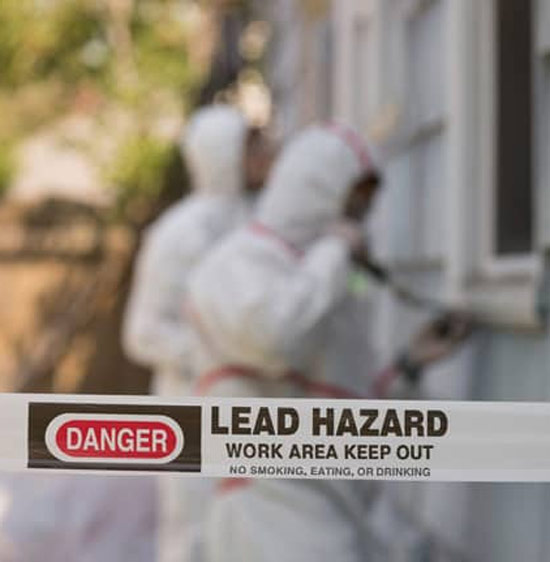NYC Lead Removal Contractors-- Obtain Safe and Efficient Services
NYC Lead Removal Contractors-- Obtain Safe and Efficient Services
Blog Article
Crucial Devices and Methods for Effective Lead Violation Cleanup
Resolving lead violations properly requires a detailed strategy that blends the right devices with strategic methodologies. Simultaneously, the usage of specialized cleanup tools, such as HEPA vacuums and lead-specific cleaning representatives, is crucial for thorough contaminant removal. Efficient control techniques, including plastic sheet and negative air pressure systems, are necessary to protect against the spread of hazardous products.
Individual Safety Tools
Personal safety tools (PPE) is an essential part in the efficient administration of lead contamination cleanup. The important PPE for lead cleanup consists of respirators, safety garments, handwear covers, and eye protection.
Respirators, particularly those equipped with HEPA filters, are essential for filtering system air-borne lead particles, avoiding breathing. Appropriate fit and seal checks are essential to guarantee their effectiveness. Protective apparel, including coveralls and non reusable suits, prevents lead dust from adhering to employees' garments, decreasing the danger of secondary contamination. Handwear covers, commonly made from nitrile or latex, shield the skin from straight contact with lead, while security goggles or full-face guards protect the eyes from dust and particles.
Furthermore, strenuous training on the right use and upkeep of PPE is vital. Employees have to be informed on donning and doffing procedures to prevent contamination. Routine inspections and substitutes of PPE parts are necessary to preserve their safety capacities, guaranteeing a risk-free and certified cleaning procedure.
Specialized Cleaning Equipment

Another important device is the wet/dry vacuum, which can successfully tidy up both dirt and fluid contaminants. These vacuums often come with HEPA filters to give an added layer of security. Damp cleans or tack towels are also essential for surface area cleansing; they are specifically made to catch and hold lead fragments, decreasing the risk of spreading out contamination.
For even more persistent deposits, specialized lead-removal cleaning representatives are called for. These representatives are created to break down lead fragments, making them less complicated to remove. Scrub brushes with tough bristles can assist in this process, particularly on rough surface areas where lead dirt has a tendency to stick extra strongly.
Additionally, encapsulants are used to secure lead-contaminated surfaces, avoiding the launch of lead dirt. These specialized paints and layers are designed to stick to various substratums, supplying a long-lasting service for lead control.
Reliable Containment Techniques
Effective containment techniques are crucial in minimizing the spread of lead contamination during cleanup activities. Executing robust control methods makes certain that lead bits do not move to untouched locations, therefore protecting both employees and the environment (DOH & HPD Lead Violation Removal NYC).

To enhance control, encapsulants can be put on surfaces that are not being eliminated or disturbed. These specialized finishings bind lead dust, lowering its accessibility for resuspension. Additionally, all workers have to wear appropriate Individual Protective Tools (PPE), consisting of respirators and disposable fits, to stop contamination spread.
Safe Disposal Practices
Guaranteeing risk-free disposal techniques is an important element in the administration of lead contamination cleaning. Correct disposal mitigates the threat of lead coming back the atmosphere and jeopardizing public wellness (DOH & HPD Lead Violation Removal NYC).
Transferring lead waste needs adherence to strict guidelines. Making use of certified contaminated materials providers guarantees that the products are dealt with properly. Documentation, consisting of materializes outlining the type and amount of waste, must go along with deliveries to track the waste from the site of origin to its final disposal destination.
Designated contaminated materials disposal centers are outfitted to handle lead-contaminated materials securely. These facilities commonly use sophisticated Your Domain Name approaches such as stabilization, solidification, or chemical treatment to counteract the lead before disposal. Landfilling in specialized, lined areas that avoid leachate from contaminating groundwater is a common technique for final disposal.
Routine training for personnel included in lead waste disposal is vital to keep safety requirements and prevent unintended direct exposure. By sticking to these practices, organizations can dramatically decrease the ecological and health and wellness influences related to lead contamination.
Regulatory Compliance Tips

Sticking to regulatory compliance is extremely important in the successful implementation of lead contamination clean-up. Understanding and following federal, state, and regional guidelines guarantees not only the safety and security and health of individuals however also the lawful and monetary health of the clean-up company. The Environmental Defense Firm (EPA) sets stringent criteria, such as the Lead Renovation, Repair Work, and Paint (RRP) Regulation, which mandates appropriate qualification and training for specialists handling lead-based activities.
Conformity begins with a comprehensive analysis of applicable regulations and laws. Organizations has to remain updated on any legal modifications, which can be visit this web-site promoted with normal training sessions and registering for sector updates. Paperwork is one more crucial conformity element; maintaining comprehensive records of all tasks, consisting of assessment records, employee training logs, and disposal shows up, is essential.
In addition, involving with licensed lead examiners or risk Click This Link assessors makes certain that lead hazards are correctly determined and alleviated. Employers have to enforce making use of Individual Protective Tools (PPE) and ensure that security protocols are strictly complied with. Transparent interaction with stakeholders, including employees, customers, and regulative bodies, will cultivate a culture of conformity and responsibility, eventually contributing to a more secure and more efficient lead cleanup procedure.
Verdict
Effective lead infraction clean-up requires the assimilation of specialized devices and critical techniques to make sure safety and security and efficacy. Making use of HEPA vacuum cleaners, specialized cleaning up agents, and reliable control methods such as plastic bed linen and unfavorable atmospheric pressure systems is imperative. Individual protective tools (PPE) safeguards workers from direct exposure, while risk-free disposal techniques and rigorous adherence to governing compliance are essential for responsibly managing dangerous waste. Jointly, these steps significantly reduce wellness dangers and contribute to a cleaner environment.
Report this page